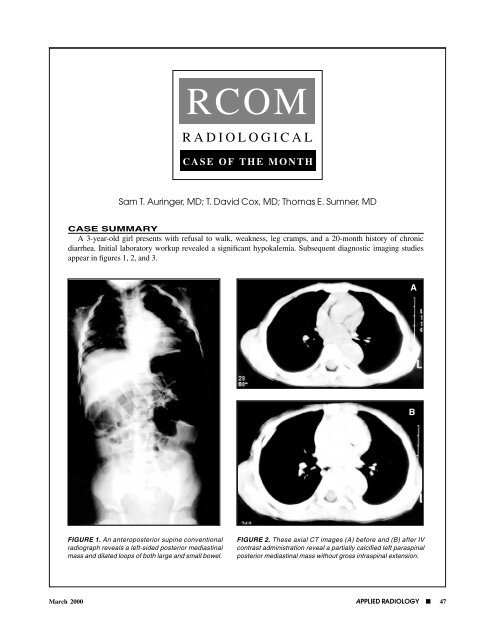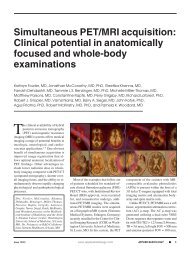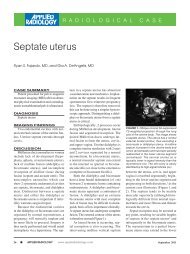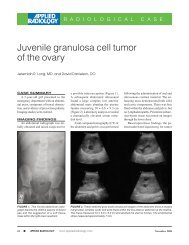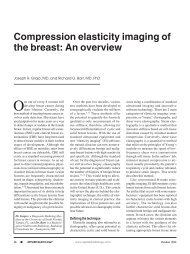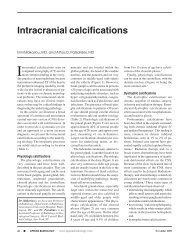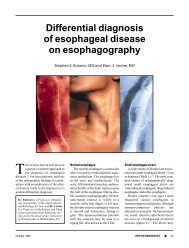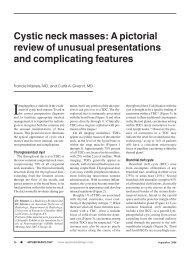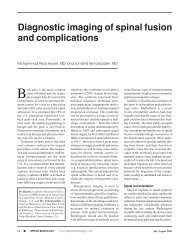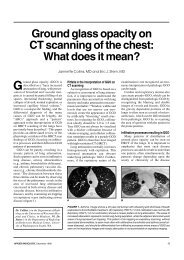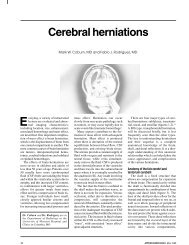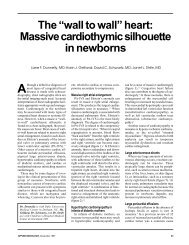Download PDF - Applied Radiology Online
Download PDF - Applied Radiology Online
Download PDF - Applied Radiology Online
You also want an ePaper? Increase the reach of your titles
YUMPU automatically turns print PDFs into web optimized ePapers that Google loves.
RCOM<br />
RADIOLOGICAL<br />
CASE OF THE MONTH<br />
Sam T. Auringer, MD; T. David Cox, MD; Thomas E. Sumner, MD<br />
CASE SUMMARY<br />
A 3-year-old girl presents with refusal to walk, weakness, leg cramps, and a 20-month history of chronic<br />
diarrhea. Initial laboratory workup revealed a significant hypokalemia. Subsequent diagnostic imaging studies<br />
appear in figures 1, 2, and 3.<br />
A<br />
B<br />
FIGURE 1. An anteroposterior supine conventional<br />
radiograph reveals a left-sided posterior mediastinal<br />
mass and dilated loops of both large and small bowel.<br />
FIGURE 2. These axial CT images (A) before and (B) after IV<br />
contrast administration reveal a partially calcified left paraspinal<br />
posterior mediastinal mass without gross intraspinal extension.<br />
March 2000<br />
APPLIED RADIOLOGY ■ 47
FIGURE 3. An axial CT image of the pelvis demonstrates<br />
multiple fluid-filled bowel loops.<br />
DIAGNOSIS<br />
Thoracic ganglioneuroma presenting with the<br />
watery diarrhea, hypokalemia, and achlorhydria<br />
(WDHA) syndrome.<br />
IMAGING FINDINGS<br />
Findings indicative of a posterior mediastinal<br />
mass on plain film and chest computed tomography<br />
(CT) scans suggest the diagnosis of a neurogenic<br />
tumor, as 95% of pediatric posterior mediastinal<br />
masses are of neurogenic origin. The primary<br />
differential considerations are tumors of sympathetic<br />
ganglion origin (i.e., neuroblastoma, ganglioneuroblastoma,<br />
and ganglioneuroma). 1 The patient’s age<br />
favored a neuroblastoma or ganglioneuroblastoma, as<br />
ganglioneuroma tends to occur in older children.<br />
Plain film findings of thoracic neuroblastoma include<br />
a posterior mediastinal mass, possibly associated<br />
with ribs that are splayed or eroded or both;<br />
calcifications; and enlarged intervertebral foramina in<br />
cases with intraspinal extension of tumor. CT<br />
demonstrates calcification in approximately 90% of<br />
neuroblastomas. Magnetic resonance (MR) imaging<br />
is the test of choice for thorough evaluation of<br />
intraspinal extension of tumor. 2<br />
DISCUSSION<br />
The WDHA syndrome is an unusual paraneoplastic<br />
condition caused by excess vasoactive intestinal<br />
peptide (VIP) secretion by certain tumors,<br />
including the neuroblastoma-ganglioneuroblastomaganglioneuroma<br />
spectrum in children and non-beta<br />
pancreatic islet cell tumors, squamous cell tumors<br />
of the lung or esophagus, cutaneous mast cell tumors,<br />
and pheochromocytomas in adults. 3 Ganglioneuromatosis<br />
of the small intestine and pancreas,<br />
causing hypersecretion of VIP, has been reported. 4<br />
The WDHA syndrome has also been referred to as<br />
the vipoma syndrome, pancreatic cholera, the<br />
watery diarrhea syndrome, and the Verner-Morrison<br />
syndrome after its discoverers in 1958. 5 Clinically, the<br />
onset of WDHA syndrome is typically insidious and<br />
diagnosis is often delayed for months or even years.<br />
The clinical hallmark is an unremitting secretory<br />
diarrhea that persists despite fasting. Diagnosis<br />
requires documentation of elevated serum VIP levels<br />
with subsequent localization of the VIP-secreting<br />
tumor. Surgical resection is usually curative, as it was<br />
in this case.<br />
REFERENCES<br />
1. Hedlund GL, Griscom NT, Cleveland RH, Kirks DR: Respiratory system. In: Kirks DR (ed): Practical Pediatric Imaging: Diagnostic <strong>Radiology</strong><br />
of Infants and Children, ed 3, pp 790-792. Philadelphia, Lippincott-Raven, 1998.<br />
2. Abramson SJ: Adrenal neoplasms in children. Radiol Clin North Am 35:1415-1453, 1997.<br />
3. Grier JF: WDHA (watery diarrhea, hypokalemia, achlorhydria) syndrome: Clinical features, diagnosis, and treatment. South Med J 88:22-24,<br />
1995.<br />
4. Shulman DI, McClenathan DT, Harmel RP, et al: Ganglioneuromatosis involving the small intestine and pancreas of a child and causing<br />
hypersecretion of vasoactive intestinal polypeptide. J Pediatr Gastroenterol Nutri 22:212-218, 1996.<br />
5. Castleberry RP: Biology and treatment of neuroblastoma. Pediatr Clin North Am 44:919936, 1997.<br />
Prepared by Sam T. Auringer, MD; T. David Cox, MD; and Thomas E. Sumner, MD, Department of <strong>Radiology</strong>,<br />
Wake Forest University Baptist Medical Center, Winston-Salem, NC.<br />
48 ■ APPLIED RADIOLOGY March 2000


